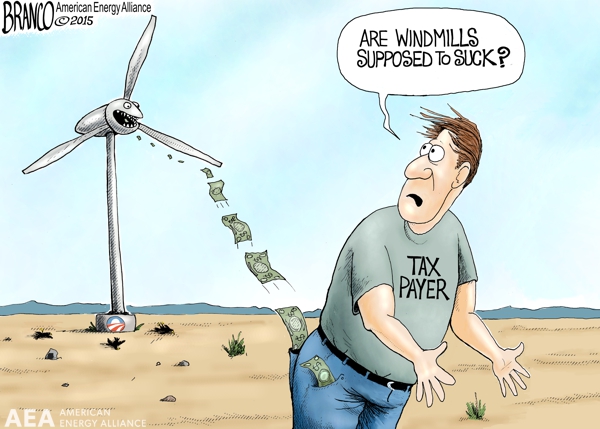This week, Reps. Kenny Marchant and Mike Pompeo introduced H.R. 1901, a bill to eliminate the wind Production Tax Credit (PTC).This legislation has several important provisions. First, it repeals the inflation adjustment, which would save taxpayers approximately 35% for the reminder of the ten-year window. It slightly adjusts and tightens the “beginning of construction” language that determines whether a company qualifies for the subsidy. It also repeals the entire statutory framework on December 31, 2025 to ensure the subsidies do not drag out beyond the next decade. Lastly, it includes a sense of Congress that the PTC should not be extended and should remain expired.
If this legislation were to become law it would effectively wind down and end this taxpayer-funded subsidy. Below are ten reasons why Congress should eliminate the wind PTC:
1. It Increases Electricity Costs. Wind generation is not reliable because wind units produce electricity when the wind blows, not necessarily when people want electricity. Adding wind generation to the electric grid does not increase the usable capacity of the grid, because there are times when the wind does not blow. Wind, therefore, does not reduce the amount of reliable generation that is required to keep the lights on. As noted below, the PTC leads to cannibalistic pricing behavior, which makes some low-cost, reliable generators uneconomic. The reliable generators will need to be replaced with new facilities, increasing the cost of electricity in the long run.
2. It is a Special Interest Handout: As Warren Buffett explains, “On wind energy, we get a tax credit if we build a lot of wind farms. That’s the only reason to build them. They don’t make sense without the tax credit.” Buffett made it clear that the PTC is most beneficial to wealthy wind developers who are able to reduce their tax rate at the expense of the rest of the taxpayers and ratepayers.
3. It Threatens the Reliability of the Electricity Grid: No matter how many subsidies and mandates the government provides to prop up wind energy, they cannot fix one of its fundamental flaws: unreliability. The wind follows the weather, not Americans’ energy needs. In fact, wind output is often lowest when energy demand is highest. This constant variation of wind output puts significant strain on the electric grid, which increases the risk of blackouts.
4. It Encourages “Cannibal Behavior”: The PTC allows wind producers to pay the grid to take their power and still profit. This “negative pricing”—or “cannibal behavior” as The New York Times reported—has contributed to premature plant retirements, including Dominion’s Kewaunee Nuclear Plant and Entergy’s Vermont Yankee Nuclear Plant.
5. It Destroys More Jobs than it Creates: The PTC leads to net destruction of jobs by diverting capital away from projects that make the most financial sense and increasing the cost of electricity in the long run. For instance, an analysis of Spain’s green energy subsidies found that for every job created, 2.2 jobs were destroyed elsewhere in the economy.
6. It Stifles Innovation: Industries that grow dependent on government are much less likely innovate to make their product better. The Wind PTC is over 20 years old. The technology of wind energy, compared to other energy sources (think massive technology advances in oil and natural gas), has not significantly improved over those three decades—wind power still cannot help keep the lights on when the wind isn’t blowing. These handouts have contributed to its failure to become market viable.
7. It is Crucial to the EPA Power Plant Regulations: The EPA is pursuing aggressive regulations of existing power plants that amount to a federal takeover of the electricity system. One of the goals of this regulation is to shift electricity from sources like coal toward renewable energy like wind. Without the Wind PTC, mandating renewables is a much more difficult task. Extending the Wind PTC helps enable this federal takeover by the EPA.
8. It Ignores Environmental Drawbacks of Wind Energy: Advocates dub wind “Clean Energy,” yet wind has numerous environmental drawbacks. Wind facilities kill millions of birds and bats, including endangered and threated species like bald and golden eagles. In addition, wind turbines are manufactured with rare earth minerals mined mostly from China under horrific environmental conditions. Lastly, industrial wind developments use a lot of land for a small amount of energy
9. It Props Up an Old, Failed Technology: Wind energy is not a new, “infant” industry as the wind lobby claims. Wind turbines have been used to produce electricity for over 100 years. It did not take long to figure out back then that wind was an unreliable, expensive form of energy. Despite billions of dollars in taxpayer support over decades, not much has changed today. Wind is still an unreliable, expensive form of energy.
10. It Promotes an Energy Source that Depends on Other Energy Sources: Many proponents of the PTC claim wind energy can break our “dependence” on fossil fuels. Yet, wind energy would not be possible without natural gas, oil, and coal. These fuels are needed to manufacture, deliver, and maintain wind turbines. Additionally, back up power, dominated by natural gas and coal, is necessary because of the earlier mentioned reliability issues with wind. Wind is very much dependent on other fuels and would not be possible without them.
The American Energy Alliance supports eliminating the wind PTC and urges all Members of Congress to co-sponsor H.R. 1901. Co-sponsorship of this legislation will be calculated into our American Energy Scorecard.
Click here for AEA’s scorecard alert for H.R. 1901
